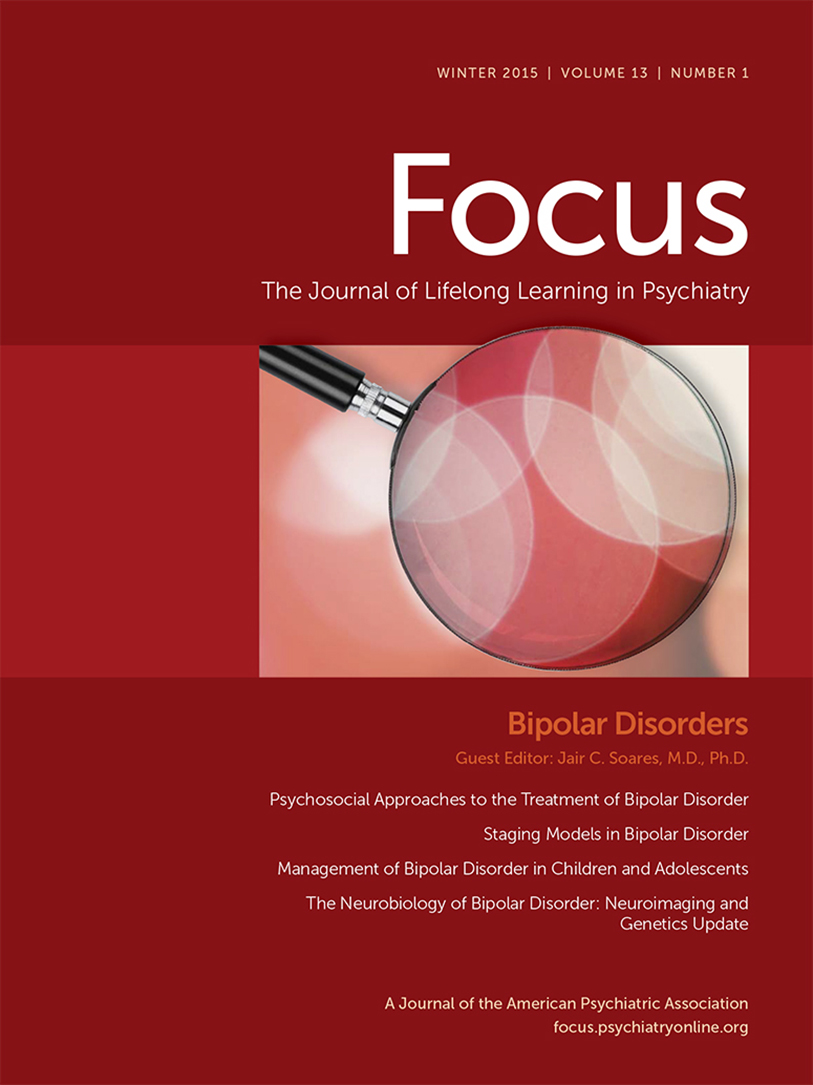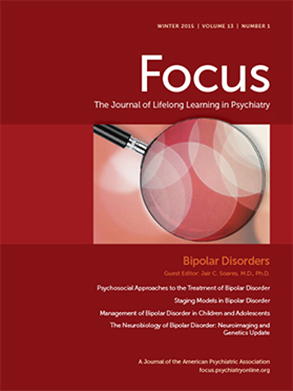Medicine is an art whose magic and creative ability have long been recognized as residing in the interpersonal aspects of patient–physician relationship (
1).
Bipolar disorder may be categorized as a “chronic, cyclic disease” (
2). As with other chronic illnesses, prolonged, close adherence to a treatment regimen is necessary for optimal prognosis. Despite an increase in the number of effective medications, the efficacy–effectiveness gap in clinical practice suggests that adherence is a major problem in the treatment of bipolar disorder and one that contributes substantially to the burden of morbidity and mortality of the illness (
3).
The term “compliance” has been used to describe whether or not a patient follows the treatment recommendations of the physician. However, this term connotes a passive acceptance by the patient to the recommended treatment and assumes that “the doctor knows best.” Although physicians do have knowledge about illness and effective treatments, the needs of each patient in terms of understanding and accepting their illness, lifestyle, culture, values, religion, and other factors are crucial in crafting the most effective treatment plan (
4). Patients who feel listened to, who feel that their needs and desires are taken seriously, and who are involved in their treatment planning tend to be more adherent to treatment (
5). Bultman and Svarstad (
6) found that a “collaborative or participatory communication style” between physician and patient had a positive impact on treatment and medication adherence. This communication style encouraged mutual exchange of information between patient and doctor, highlighted listening to each other’s point of view, considered treatment a partnership for solving problems and resolving conflict, and emphasized the patient’s active role in treatment planning.
Adherence to medication in bipolar disorder may be influenced by a number of patient, physician, environment, illness, and treatment variables. Full adherence to medication treatment in bipolar disorder is not the norm—adherence is typically partial or intermittent (
7). For individuals in the hypomanic to manic phase of the disease, the euphoria may be compelling, decreasing the patient’s motivation to take medication to quell this “high.” For individuals in the depths of depression, lack of motivation, apathy, and passive or active self-destructive wishes may impair treatment adherence. Patients’ fear of side effects and negative attitudes toward long-term prophylaxis for bipolar disorder may influence adherence to medication more than experiencing actual adverse reactions to medications (
8). These factors make a strong treatment alliance particularly crucial in the treatment of patients with bipolar illness. Psychosocial interventions such as psychoeducation, participatory treatment planning, and a supportive collaborative care network improve prognosis.
The concept of the therapeutic alliance highlights the psychiatrist’s task of facilitating the factors that will improve treatment success. For example, in the National Institute of Mental Health Treatment of Depression Collaborative Research Program, the therapeutic alliance was associated with a higher variance in outcome (21%) than any specific psychotherapeutic or psychopharmacologic treatment approach (
9). The study authors suggested that the therapeutic relationship may be a nonspecific factor that provides a “holding environment” in which issues related to taking medication can be addressed (
9,
10). Likewise, the National Depression and Manic-Depression Association survey (
11) reported that patients who were more satisfied with their provider were able to come to terms with their illness more readily, felt more able to cope with their illness, were less angry and ashamed about the illness, and were more likely to adhere to their medication regime. Effective and collaborative doctor–patient communication improves outcome.
Weiss and colleagues (
12) used the Pharmacotherapy Alliance Scale to study the effects of the therapeutic alliance on pharmacotherapy for depression. A rather unexpected finding, and in contrast to some other studies, was the result that 41% of the outcome variance could be explained by the therapists’ ratings of the alliance, while only 25% of the variance could be explained by the patients’ ratings. Although this may seem counterintuitive, it suggests that therapists may key into essential components of the relationship, even when a patient is too depressed or hopeless to appreciate it. The connection and hope that the therapist feels may be communicated to the patient in a sustaining manner, even if not overtly appreciated.
Clinical Vignette
Tom bounded into the waiting area of the psychiatrist’s office, a smile on his face and a newly plucked bouquet of flowers clutched in his palm. “Hello, Doc!” he crowed, when Dr. Kim opened her office door to greet him. Tom handed her the flowers—“I picked up a little something for you,” he said, laughing. “Get it—picked up a little something.” When Dr. Kim looked somewhat perplexed by Tom’s presentation, he continued, “You know, I picked the flowers.” Dr. Kim smiled warmly. “Yes, thank you,” she replied.
Tom did not sit immediately upon entering the office. He walked around, looking at Dr. Kim’s books and commenting on them. “I always wanted to write a book,” Tom mused. “You know, the great American novel. I think now may be the time.” Dr. Kim gazed directly at Tom. “You seem full of energy today,” she noted. “And you are talking very fast. It must feel good to be so very happy, but last time you were like this you ended up in the hospital. Shall I assume you have not been taking your medications regularly?”
“Now Doc,” Tom replied dramatically, a false look of hurt on his face. “I’m getting my life sorted out. I have a direction. I understand myself. I am destined for greatness! Don’t worry. I won’t end up in the hospital again,” he said emphatically. A look of concern came over Dr. Kim’s face. “Tom, you and I have worked very hard on coming up with a treatment plan that you can live with and that will help you reach your goals. Do you remember how we went back and forth figuring out your plan and how you really felt that you needed medication to keep you on track?” “But Doc, you don’t understand! This time is different!” “Ah,” Dr. Kim answered empathically. “But do you remember how you told me that if you stopped taking your medications, I should bring out the paper that you wrote your goals on?”
Dr. Kim went to her desk and retrieved a handwritten document with 3 goals, signed by Tom. It was dated 3 months earlier. She handed it to him. He took it from her and started to rip it up, but stopped himself. “One of the goals you have for yourself is to stay on your medication for at least a year,” Dr. Kim noted. “But Doc,” Tom protested, handing the paper back to Dr. Kim. “So, are you going to send me back to the hospital?” Tom queried, a look of apprehension in his eyes. “Only if you need it,” replied Dr. Kim. “Perhaps we can ask the visiting nurse to come back in to your apartment to monitor your medications.”
“You drive a hard bargain, Doc,” Tom quipped, smiling again. “You know that I’m a master of disguise and can always cheek my meds,” he said slyly, looking intently at Dr. Kim for her reaction. “I know that you are an honest man that has made a pledge to continue to take your medications for a year. Please take your medications as prescribed,” Dr. Kim retorted. “You know what the problem with doctors is—no sense of humor. Okay, Okay—I’ll take my medication,” Tom replied, rolling his eyes. Dr. Kim’s warm smile returned. “You’re bright and talented and have a great plan for your future. Stick with the plan, my man,” Dr. Kim quipped back as Tom stood up. He opened the door, turned, and winked at Dr. Kim and then closed the door quietly.
Tips for Enhancing Engagement with Individuals in Treatment for Bipolar Disorder
The nature of bipolar disorder, with changing moods and the cognitive misperceptions that follow them, requires special skill for the clinician in negotiating the treatment alliance (
4). The clinician needs to anticipate that the patient may not want to acknowledge lack of adherence during manic periods, may withdraw from treatment during depression, and may have particularly high risk of self-harm, harm to others, or legal consequences during periods of poor illness control. Identifying patient aspirations early and reinforcing the therapeutic bond via joint work toward these goals may be the best buffer for maintaining a strong alliance during the roller coaster of moods for a bipolar patient.
1.
From the first interactions, highlight the importance of honesty and trust (on both sides) in the therapeutic relationship, specifying clearly the treatment approach, areas of choice, limits of confidentiality, and safety management plans.
2.
Listen carefully to aspirations, beliefs, and concerns and acknowledge these regularly.
3.
Stress that treatment is an ongoing dialogue, requiring acknowledgment of lack of agreement with the treatment plan and working these out.
4.
Write down agreed-upon goals and treatment plans. Refer to these regularly and determine how often they may be modified. If a medication trial is agreed upon, specify how long it will be followed and the indications for a change in the medication plan. Once the plan is agreed upon, physician and patient should sign.
5.
Specify a safety plan, ask regularly about safety (and weapons, pills, etc. in the home), and the coverage and plan for the patient if he/she is not feeling safe.
6.
Acknowledge appreciation of honesty and the efforts of the patient at illness management.
7.
Work in a collaborative team whenever possible, with regular and specified methods of team communication with each other and integrating the patient into these discussions whenever possible.

